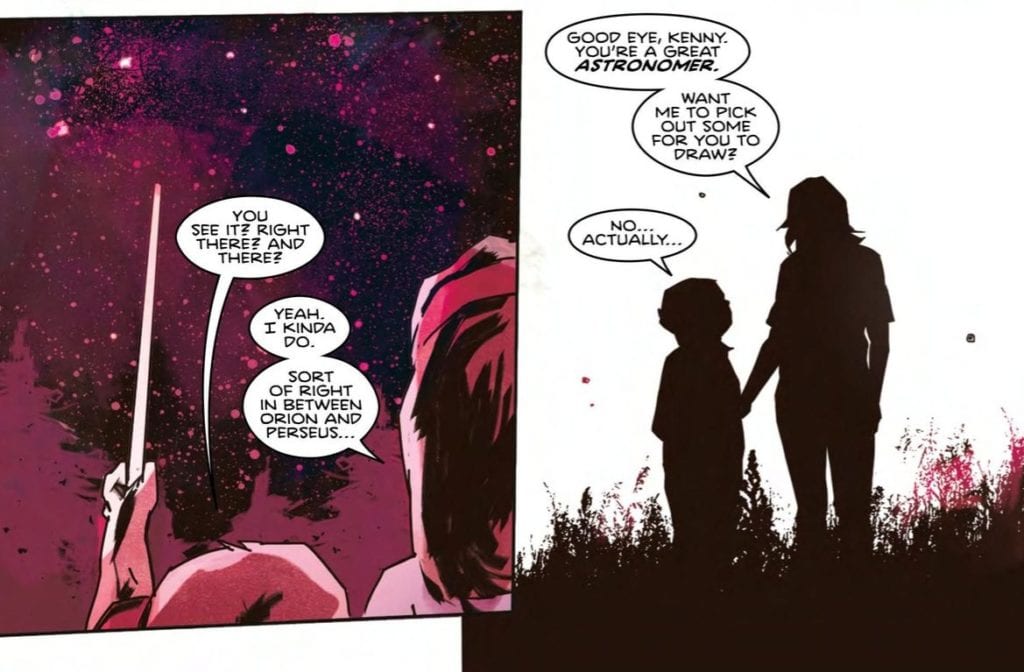A jaw dropping opening and an unexplained event sets the scene for Mad Cave’s new science fiction series Stargazer. The relatively new independent publisher has a number of titles already under their belts but this year sees a range of new offerings covering a number of genres. Stargazer is part X-Files, part Close Encounters of the Third Kind, and part Saucer County. It hides it’s science fiction roots under great characters and a mysterious narrative, never giving too much away.
The story starts in the late 1990’s with a bunch of kids getting into trouble. Unfortunately for them the trouble escalates and the consequences come back to haunt them later in their lives. But for one of their group, Kenny, the ‘trouble’ never goes away and his life is ruled by fear and his absolute belief that he was abducted by Aliens.

Openings
Any story that starts with an alien abduction is instantly going to be compared to a number of movies, television shows, and comics: It is impossible to escape classics such as The X-Files. The trick is finding a new way to tell the story, to surprise the reader from the outset so that any comparisons are forgotten until the entire issue has been read. Anthony Cleveland begins Stargazer with a very short opening that does just that.
The opening includes an enigmatic doctor, a collection of Agents, and a scene of absurdity that it could almost feature in a Douglas Adams book. The setting is instantly engaging thanks to the superb color work by Stefano Simeone who gives everything a dust enshrouded haze; creating a hot and uncomfortable place. You can’t help but gag on the air that Simeone illustrates with swipes of red and orange across the panels with almost no regard for Antonio Fuso’s inks.
The two page spread that greats the reader is a double hit. First you get the shock of the Doctor, her reaction spilling from an insert panel as her speech crosses the panel border into the image below. The second is the inescapable image of death filling most of the main image. You know that what you are looking at can’t exist in the place that has been expertly described by the art and yet the image is no lie.
As an opening to a comic, Stargazer has it spot on.

Establishing Character
After this opening, the narrative becomes more recognisable with a group of kids out in the woods. This is comfortable territory for the reader and for the writer. Cleveland uses these pages to establish fairly quickly the dynamic of the group, making sweeping statements about the characters and their relationships with each other. It is not important to bring out the complexities of each individual but to get an overview of the cast, something that Cleveland does successfully.
Fuso uses a collection of mid range shots in the panels in order to focus on particular members of the group but never in isolation. This helps to make the audience a part of the group and not an outsider. This reinforces the closeness of the kids. Even Kenny, who feels like an outsider to his sister and her friends, is still a dominant part of the group.
It is only when things start to go side-wards that isolation becomes part of the panels. Kenny is soon separated from the group through a number of visual signifiers, such as a metal rail distancing him from the others. Panels begin to feature Kenny and Kenny alone, making his experience more important. The reader suddenly finds themselves following a single character instead of a group.
This shift in focus draws the reader closer to the action and pulls us emotionally into the comic. When the narrative jumps forward in time, the effects of the experience are still fresh in our minds and helps us to understand the reactions of the kids when they are all grown up.

The Good and The Not So Good
The opening half of the comic engages the reader on an emotional level, pulling at the heartstrings. The artwork helps this by having wonderfully rendered characters and a slightly uncomfortable obsession with irregular panel shapes.
As the comic moves into the modern day the panels become more regular in shape except when the central character is under stress or talk returns to their experience as children. Fuso does a beautiful job of leading the reader through these emotional moments, signalling the emotional shifts through the use of panel layouts.
The lettering by Justin Birch also helps to lead the reader through the pages, creating a steady pace that is broken in some scenes of character tension. There are, however, moments where the speech balloons are inconsistent, especially where they butt up against the panel borders. On occasions the balloon ends flat against the frame, other times it breaks through and the balloon interior bleeds into the gutter. While off putting in places it doesn’t jar the reading experience.
The coloring can also be off putting in places. Simeone’s decision to limit the color palette throughout pays dividends during some of the scenes, especially the opening pages. The atmosphere is created quickly and effectively. Unfortunately, with later scenes, this approach generates conflicting readings of a situation. It is not always clear what the mood of the scene is. Some of the character interactions are cold and distant which are understandable. However, there are moments that move from one emotional state to another but are difficult to understand. This is because the coloring doesn’t change, or changes to subtly. If this was realistic coloring the continuity of color would be acceptable but with these sweeping emotional colors the lack of change is more noticeable.
Conclusion
When Stargazer works, it works really well. Each of the creators pull together to produce an enthralling piece of work. Despite the similarities to a number of other Alien Abduction stories, Stargazer manages to impress with enough shocking or emotional moments to make the reader forget about comparisons.
The cliches of the genre are apparent throughout but it’s as if Cleveland leans into them, embracing the imagery, instead of trying to cover them up. The outcome is something that feels like an homage instead of a rip-off. It almost makes you wonder if there is more going on behind the images. Is it all as it seems?
Stargazer #1 is an exciting first issue with a number of stand out moments. There are a number of great characters to follow and art work that impresses more often than not. This is an easy comic to recommend, especially if you feel there’s an X-Files shaped hole in your life.
Stargazer by Mad Cave Studios and is available now both physically and digitally.

